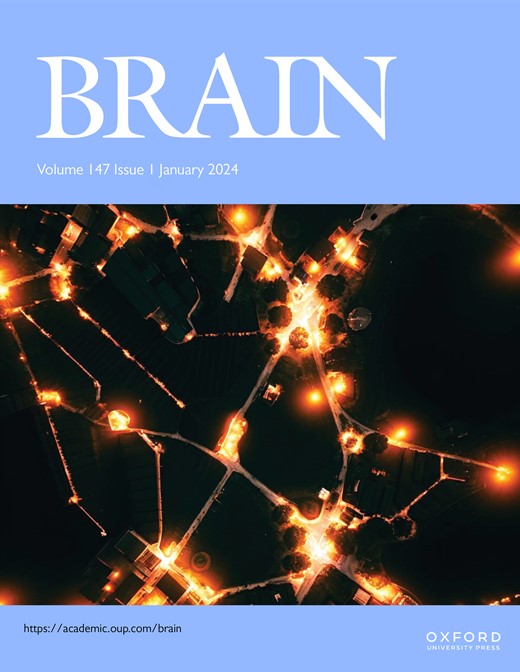Decoding inflammatory pathways in spinal muscular atrophy: implications for next-generation therapies.
IF 11.7
1区 医学
Q1 CLINICAL NEUROLOGY
引用次数: 0
Abstract
Spinal muscular atrophy (SMA) is a devastating neurodegenerative disorder caused by SMN1 gene mutations that lead to compromised production of survival motor neuron (SMN) protein. The inflammatory footprint of SMA extends beyond neural tissues, leading to significant inflammatory manifestations across multiple body systems. In motor neurons, several molecular pathways contribute to local degeneration: cytokine activation, purinergic signalling, NF-κB pathway stimulation, complement cascade activation, and glutamate excitotoxicity. These mechanisms, which involve reactive glial and immune cells, trigger neuroinflammation and non-cell-autonomous death processes that can affect non-neural organ systems. Biological samples from patients with SMA and model systems of SMA consistently exhibit altered immune patterns, elevated inflammatory markers, and immunocyte and glial dysfunction. Even revolutionary SMN-restoring therapy for SMA may not treat the potential inflammation-related aspects of the disease. Current research has identified both anti-inflammatory and pro-inflammatory effects and outcomes after SMN restoration, with unclear implications. Preclinical investigations targeting inflammation in SMA models have yielded promising findings, although optimal intervention timing requires refinement. Despite these encouraging results, translation to clinical practice remains unrealized. The field requires advanced investigative approaches, particularly single-cell RNA sequencing, to elucidate inflammatory molecular pathways, identify novel biomarkers for early detection, and develop targeted anti-inflammatory agents that complement SMN-augmenting therapies. Understanding the inflammatory mechanisms associated with SMA is crucial for developing effective combination therapies addressing both SMN deficiency and inflammatory processes. Elucidating inflammation timing and mechanisms will inform optimal intervention windows and identify patients most likely to benefit from combined treatment approaches. Future research should prioritize personalized strategies targeting both SMN-dependent and inflammatory pathways.解码脊髓性肌萎缩的炎症通路:对下一代治疗的影响。
脊髓性肌萎缩症(SMA)是一种毁灭性的神经退行性疾病,由SMN1基因突变引起,导致存活运动神经元(SMN)蛋白的产生受损。SMA的炎症足迹延伸到神经组织之外,导致多个身体系统的显著炎症表现。在运动神经元中,有几种分子通路有助于局部变性:细胞因子激活、嘌呤能信号传导、NF-κB通路刺激、补体级联激活和谷氨酸兴奋毒性。这些机制包括反应性胶质细胞和免疫细胞,引发神经炎症和非细胞自主死亡过程,可影响非神经器官系统。来自SMA患者和SMA模型系统的生物样本一致表现出免疫模式改变、炎症标志物升高、免疫细胞和神经胶质功能障碍。即使是革命性的SMA恢复疗法也可能无法治疗该疾病的潜在炎症相关方面。目前的研究已经确定了SMN修复后的抗炎和促炎作用和结果,但不清楚其含义。针对SMA模型炎症的临床前研究已经产生了有希望的发现,尽管最佳干预时间需要改进。尽管这些令人鼓舞的结果,翻译到临床实践仍未实现。该领域需要先进的研究方法,特别是单细胞RNA测序,以阐明炎症分子途径,识别早期检测的新型生物标志物,并开发靶向抗炎剂,以补充smn增强疗法。了解与SMA相关的炎症机制对于开发针对SMN缺乏和炎症过程的有效联合疗法至关重要。阐明炎症时间和机制将为最佳干预窗口提供信息,并确定最有可能从联合治疗方法中受益的患者。未来的研究应优先考虑针对smn依赖性通路和炎症通路的个性化策略。
本文章由计算机程序翻译,如有差异,请以英文原文为准。
求助全文
约1分钟内获得全文
求助全文
来源期刊

Brain
医学-临床神经学
CiteScore
20.30
自引率
4.10%
发文量
458
审稿时长
3-6 weeks
期刊介绍:
Brain, a journal focused on clinical neurology and translational neuroscience, has been publishing landmark papers since 1878. The journal aims to expand its scope by including studies that shed light on disease mechanisms and conducting innovative clinical trials for brain disorders. With a wide range of topics covered, the Editorial Board represents the international readership and diverse coverage of the journal. Accepted articles are promptly posted online, typically within a few weeks of acceptance. As of 2022, Brain holds an impressive impact factor of 14.5, according to the Journal Citation Reports.
 求助内容:
求助内容: 应助结果提醒方式:
应助结果提醒方式:


